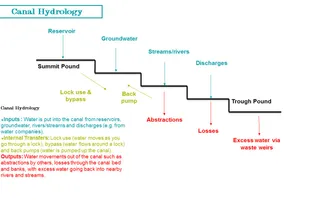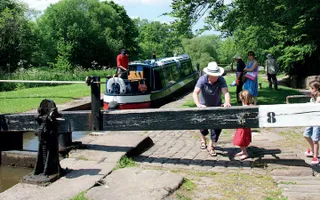When the canals were first built over 200 years ago, finding a reliable water supply to ensure that freight could be transported around the country was critical to the success of those early canal companies.
Nowadays, even though boating on the canals is mainly for recreation, the same challenges still exist. This is because every time a boat passes through a lock, thousands of litres of water are used. Also, water evaporates from the canals during warm and sunny weather, meaning that we need to regularly top up the water levels to meet these demands otherwise boats would run aground.
Supplies of water come from a network of reservoirs, rivers and streams, as well as being pumped from underground. We have a network of pumping stations at key locations to allow us to pump water back up lock flights.
The diagram below illustrates these supplies and demands:
Every week we record how much water is stored in our reservoirs and this helps us to decide which reservoirs to use. We share this information around the middle of each month in a report called Reservoir Watch. Why not take a look at the latest Reservoir Watch to see how our reservoirs are doing?
Every hour we record how many lockages occur throughout our canals and rivers at over 150 locks and this helps us see how busy our locks are and how much water we need to supply to them. We collate this information into an Annual Lockage Report which we share every January. Why not download the latest Annual Lockage Report to see which lock near you is the busiest?
Modelling
We use the information from our monitoring stations, along with historical rainfall data from the Met Office going back nearly 100 years to run computer simulation models of the canals and rivers.
These help us understand possible future changes in water supplies and demands, such as the effect of a new marina or climate change. The models are also used to guide our day to day decision making on which sources of water are the best ones for us to use.
Management
We combine the monitoring and modelling information to manage the water wisely. This can be to ensure water levels are kept topped up from day to day, but also allow us to plan effectively for the future.
This future planning is shown in our new Water Resources Strategy, setting out our aspirations for the next five years, but looking as far ahead as 2050 to understand the longer term pressures and challenges on water supply and use.
We consulted on this Strategy in autumn 2014, and produced a summary of the responses. The final Strategy was published in October 2015.
Water management team
The team is made up of water experts who undertake monitoring, modelling and management of the canals and rivers to try and ensure that we have just the right amount of water. There are thirteen hydrologists, two modellers, one hydrometric assistant, five engineers and three volunteers
Together we work hard on a day to day basis to keep the canals topped up, although this can be extremely difficult in times of drought or flood.
Email: [email protected]





